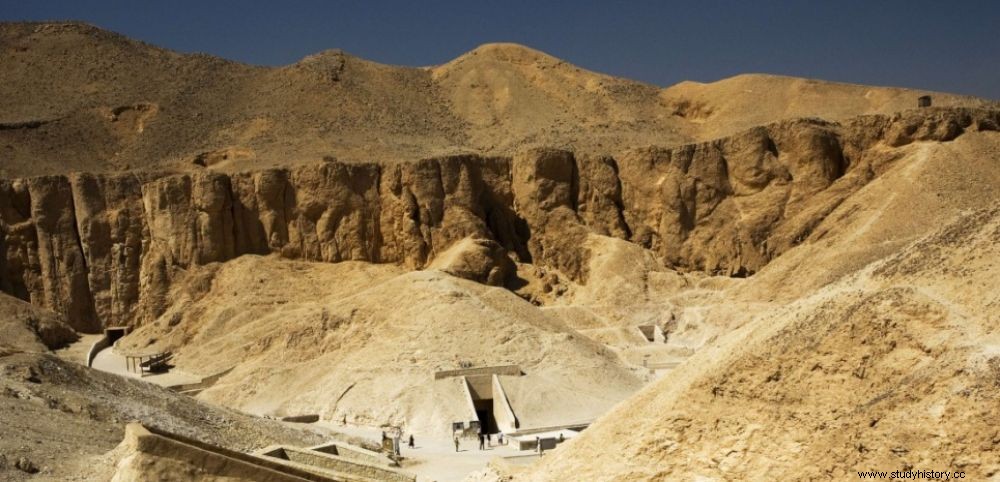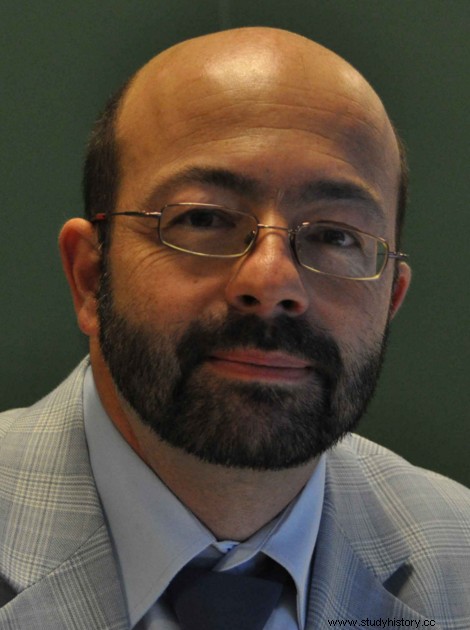 View of the Valley of the Kings near Thebes in Egypt.
View of the Valley of the Kings near Thebes in Egypt. PREDICTIONS. On the occasion of the 93 th anniversary of the discovery of the tomb of Tutankhamun, November 4, 1922, the Egyptian Ministry of Antiquities has just announced the start of the campaign of measures aimed at searching for unknown rooms in the tomb, following the hypotheses put forward by the British archaeologist Nicholas Reaves. He recently presented a bold theory:the burial of Queen Nefertiti would be concealed in an inviolate burial chamber located inside the tomb of Tutankhamun, famous pharaoh of the 18 th dynasty (1570-1293), in the Valley of the Kings, the Theban necropolis located on the west bank of the Nile, near Luxor, in Egypt. Thus, on November 5 and 6, under the aegis of the Egyptian Ministry of Antiquities, an infrared thermography campaign (1) entrusted to the faculty of engineers in Cairo and the HIP Institute of the "Scan Pyramids" project, should begin in the famous burial of the pharaoh who died in 1324 BCE, at the age of 19, in order to verify these hypotheses and try to detect the presence of two cavities behind "doors" that the British researcher would have detected.
The question that everyone is now asking is whether Nefertiti, the great royal wife of the pharaoh Akhenaton, the father of the child-king, can really be buried in this hypogeum, as Nicholas Reeves suggests. If the vast majority of specialists do not exclude that unknown rooms may be identified during future examinations, few agree on the possible presence of an occupant, and even less on the fact that it could be Nefertiti. . Some even believe that the mummy of this queen is already known! As for the proposed candidates, the name frequently mentioned is rather that of Merytaton, Tutankhamun's half-sister. We asked the Egyptologists Pascal Vernus, Pierre Tallet and Marc Gabolde to give us their opinion on these speculations concerning this tomb discovered by Howard Carter on November 4, 1922 (see box) .

Pascal Vernus , director emeritus in Egyptian linguistics and philology at the Ecole Pratique des Hautes Etudes (EPHE), in Paris.
Given the available documentation, Nefertiti cannot be found in this tomb… since we already know her mummy!"
That two rooms are hidden in Tutankhamun's tomb is not impossible... although we do not know of cases of total concealment behind decorated walls. On the other hand, that a burial is there and that it is that of Nefertiti seems to me impossible "given the documentation currently available". It is indeed plausible that the mummy of Nefertiti is already known. It could be the "Younger Lady (2) ", found in the original vault of Amenhotep II (KV35). The DNA examinations carried out by the former head of the Supreme Council of Egyptian Antiquities, Zahi Hawass, in 2010 do not invalidate this possibility, quite the contrary.
The period following the death of Akhenaten, the famous pharaoh of the 18 th dynasty is one of the most obscure and controversial in the history of Egypt. A fact, however, established:a female sovereign seems to have exercised power for at least three years in Thebes [the current Luxor, editor’s note] under the name of Ankhkheperoure. I think that Ankhkheperoure, the mysterious queen who would have reigned these three years after the death of Tutankhamun could be Nefertiti… It was believed, until recently, that Nefertiti had died before Akhenaten, but recently, an archaeological mission led by an Egyptologist from the University of Louvain (KUL - Katholiek Universteit), discovered a graffito indicating that Nefertiti was still alive in the year 16 of Akhenaten. In other words, she would have survived the death of Akhenaten. We cannot therefore refute too quickly that Nefertiti could have succeeded her husband under the name of Ankhkheperoure, especially since this queen was decked out with the epithet "the one who is useful to her husband"... which is better suited to Nefertiti only to Merytaton, the daughter of Akhenaton… Even if the Merytaton hypothesis seems entirely possible to me, I would like to emphasize that it does not impose itself unreservedly. However, if Nicholas Reeves' theory is an accumulation of speculation... this presence cannot be completely dismissed either.

Marc Gabolde, Egyptologist, lecturer at Paul Valéry-Montpellier III University. 18 e Specialist dynasty, he is the author of a recent book on "Tutankhamun" (Pygmalion edition).
What we have for the moment in the tomb of Tutankhamun are not traces of doors, but irregularities on the walls..."
Nicholas Reeves' hypothesis regarding the possible existence of two unknown coins in Tutankhamun's tomb is far from absurd. If we compare the plans of the tombs of the pharaohs of the 18 th dynasty, such as those of Amenhotep II, Touthmôsis IV and Amenhotep III, it is true that around the funerary chamber there are four annexes. These burial chambers are divided into two parts, one with six pillars, and another, lower, where the sarcophagus is located. This plan is the one seen in all the tombs of pharaohs belonging to this dynasty. However, what Nicholas Reeves observed was that the room in Tutankhamun's sarcophagus was indeed lowered, -as it was in the other tombs of the XVIIIth dynasty-, but that there were only two annexes, where one would expect four…
In the tomb of Tutankhamun, the burial chamber is about 1/3 to 1/4 smaller than all the over-deepened areas in the other tombs. For me, we feel that things have been done economically. There may not necessarily have been time to dig additional annexes. This is what happened in the tomb of his successor, King Aÿ, where only one annex was dug. In short, when you're pressed for time, you don't systematically dig four rooms... Even if at first glance, that seems to be the rule. My second observation concerns the examination of the high resolution 3D images of the walls produced by Factum Arte on which Nicholas Reeves bases his "door" hypotheses. On these quite remarkable enlargements, I have indeed noted the presence of lines, but I will rather speak of irregularities of the wall. From there to say that they conceal parts….
These traces may correspond to the junction of two teams of cutters, it may also be an attempt to dig additional chambers, which were abandoned and then quickly filled in. We have to wait for the radar examinations. If Nicholas Reeves and I know each other very well, on the Amarna period, I will say that we disagree. Unlike him, I do not think that the pharaoh queen who reigned after the death of Akhenaten, the famous Ankhkheperoure be Nefertiti! This is Merytaton, the eldest daughter of Akhenaten and Nefertiti. Gold pellets were found in the tomb of Tutankhamun, the "46GG" gold pellets according to the Carter numbering. On these pellets of two cm in diameter, appear a cartouche. On one we can read Ankhkheperure, and on the other Merytaton...! Things are very clear and it is possible to discover the details of the excavation on the Griffith Institute website. Why search for Nefertiti? We already have his mummy! The one known as "KV 35 YL", i.e. the "Younger Lady (2) " !
 Pierre Tallet , Egyptologist, lecturer at Paris-Sorbonne University. He directs several archaeological programs in Egypt.
Pierre Tallet , Egyptologist, lecturer at Paris-Sorbonne University. He directs several archaeological programs in Egypt.
The Valley of the Kings still holds mysteries. In recent years, two new graves have already been found, in 2006 (KV63) and in 2011 (KV 64). It is very likely that we will discover others..."
It is interesting to have thought that there could have been unknown rooms in this tomb. On the other hand, that there are objects inside these rooms is something else entirely. One can imagine that rooms under construction could have been redesigned, for various reasons. However, it is certain that in the idea of a multiple tomb, since Tutankhamun succeeds a half-sister or a sister who reigned for three years, and from whom he usurped a large part of the funerary material (this was not not intended!), it would be tempting to think that behind these walls could be the previous burial, namely, that which would correspond to its immediate predecessor. Not necessarily Nefertiti, but rather Merytaton.
"Nefertiti" may be the name that needed to be uttered for Nicholas Reeves' hypotheses to be verified. At the same time, I am not saying that it is impossible for Nefertiti to be discovered behind these walls, since the DNA that Marc Gabolde in particular has reanalyzed would seem to prove that Nefertiti is indeed Tutankhamun's mother. There would therefore be a very close relationship that could allow these two characters to be buried in the same tomb. But there is also Merytaton. Be that as it may, having questioned the finitude of Tutankhamun's tomb is a good idea. Either it will be a resounding discovery as important as that of Howard Carter in 1922, or it will be a flop...and flops are common in Egyptology!
VALLEY OF THE KINGS, NOVEMBER 4, 1922
"On November 4, 1922, during his sixth campaign of excavations in the Valley of the Kings, Howard Carter, when he was going to remove "cabins" above embankments, learned from workers that a step of stone dug into the rock had been unearthed. Howard Carter assigned this find the number 433. He undertook to unearth what looked like a staircase the same day. But to the northwest, below a rock , the remains of a sealed door covered with plaster were gradually uncovered, revealing fourteen steps and then seal impressions on plaster ", says the Egyptologist Marc Gabolde. Howard Carter however preferred to wait for the arrival of Lord Carnavon, the sponsor of the excavations before going further. It was therefore later in the month of November 1922, that the discovery was officially made. interior of Tutankhamun's tomb.
(1) Infrared thermography is a technology that makes it possible to detect the temperature differences inside a monument, and therefore any voids.
(2) The mummy of the "Younger Lady" was discovered in 1898 by the French archaeologist Victor Loret, in the original vault of Amenhotep II (KV35) in the Valley of the Kings. She was in the company of two other mummies, that of a young boy who could be Prince Thutmose, and an older woman, who genetics identified as Queen Tiye. This tomb had been reused as a hiding place, alongside the famous one of Deir el-Bahari, when it was a question of protecting the royal mummies from the exactions of the looters, during the great weakening of the pharaonic authority. She was the subject of a DNA analysis in Cairo, (Egypt) in 2010 and turns out to be the mother of Tutankhamun. For some researchers, this "Younger Lady" could be Nefertiti. For others, she is a total stranger.
